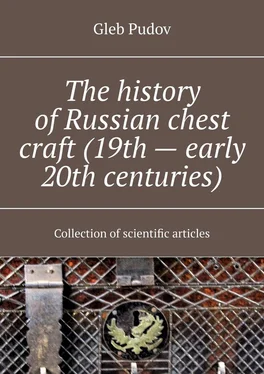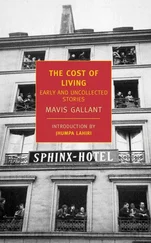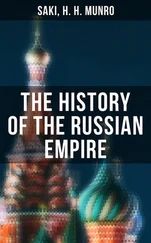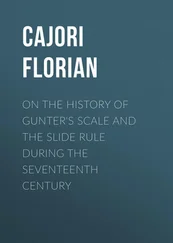Gleb Pudov - The history of Russian chest craft (19th – early 20th centuries). Collection of scientific articles
Здесь есть возможность читать онлайн «Gleb Pudov - The history of Russian chest craft (19th – early 20th centuries). Collection of scientific articles» — ознакомительный отрывок электронной книги совершенно бесплатно, а после прочтения отрывка купить полную версию. В некоторых случаях можно слушать аудио, скачать через торрент в формате fb2 и присутствует краткое содержание. ISBN: , Жанр: russian_contemporary, на английском языке. Описание произведения, (предисловие) а так же отзывы посетителей доступны на портале библиотеки ЛибКат.
- Название:The history of Russian chest craft (19th – early 20th centuries). Collection of scientific articles
- Автор:
- Жанр:
- Год:неизвестен
- ISBN:9785005637178
- Рейтинг книги:5 / 5. Голосов: 1
-
Избранное:Добавить в избранное
- Отзывы:
-
Ваша оценка:
- 100
- 1
- 2
- 3
- 4
- 5
The history of Russian chest craft (19th – early 20th centuries). Collection of scientific articles: краткое содержание, описание и аннотация
Предлагаем к чтению аннотацию, описание, краткое содержание или предисловие (зависит от того, что написал сам автор книги «The history of Russian chest craft (19th – early 20th centuries). Collection of scientific articles»). Если вы не нашли необходимую информацию о книге — напишите в комментариях, мы постараемся отыскать её.
The history of Russian chest craft (19th – early 20th centuries). Collection of scientific articles — читать онлайн ознакомительный отрывок
Ниже представлен текст книги, разбитый по страницам. Система сохранения места последней прочитанной страницы, позволяет с удобством читать онлайн бесплатно книгу «The history of Russian chest craft (19th – early 20th centuries). Collection of scientific articles», без необходимости каждый раз заново искать на чём Вы остановились. Поставьте закладку, и сможете в любой момент перейти на страницу, на которой закончили чтение.
Интервал:
Закладка:
Of particular note are products of other proportions, in their shape resembling a chest of drawers, in other words, these are podgolovniks placed on the back wall. The collection of The Department of folk art contains such a “chest of drawers” (dates back to the 18th century) 28 28 Inv. № М-34.
. Its front and side walls are upholstered with slotted iron plates with a floral ornament consisting of intertwining curls (background is brown velvet). The bottom and back side are reinforced with solid iron plates. There are several shelves and drawers inside the product, the lower part can be pulled out.
Norwegian products of this type (for example, items from the collection of the Vasa Museum 29 29 Inv. №№ 17958, 17960, 17963.
) have identical proportions, structure, they also use a combination of wood and iron. But they are almost devoid of ornaments, their main characteristics are reliability and durability.
Comparing all these items made their differences clear. They are similar only in design and shape, in all other respects they are different. This is due to the fact that chests called «podgolovnik» were made in different historical and cultural settings for different customers. The shape and design of this type of products have undergone changes not depending on the place and time of production, but the purpose and decoration.
Mention should also be made of caskets. One of their types, which must be addressed, are things of a rectangular shape, upholstered with stripes of checked pattern and equipped with curly slit overlays. Russian products of this kind were traditional products of the masters of Veliky Ustyug. For example, a box from The Department of folk art of the State Russian Museum 30 30 Inv. № М-8.
was made by master Plisov in 1834. It has rounded corners and a slightly convex lid. On the sides there are two forged handles. The box is painted with light green paint and upholstered with checked iron strips. On the front and back walls there are three slotted masks with figured leaves in the center (the middle one is the largest). In the center of the lid there is a slotted plate with a flap, in the corners there are slotted plates of the same type. There is a pattern of rounded curls on a foil background. The inscription on the lock says “City of Ustyug master Plisov 1834”.
It is appropriate to name another box from the same collection (dates back to the 19th century) 31 31 Inv. № М-350.
. It is rectangular and has a flat lid. All surfaces are upholstered with thin checked metal strips, under which blue velvet is placed. In the corners of the lid there are square slotted plates with floral ornaments, in the center there is a round plate. A similar ornament, consisting of intertwining curls, adorns the mask. The lid has a staple handle and a ring. Many items of this kind were done in Ustyug, as evidenced not only by the collection of the Department of folk art, but also by other museums 32 32 For example, in the collections of the Kostroma Museum Reserve (inv. № KMZ KOK-18119, KMZ KOK-16113), the Kotlas Museum of Local Lore (inv. № KKM KP 2553), the Nyuksenitsky Museum of Local Lore (inv. № D-778), the Kirishi Museum of Local History (inv. № IB-889) and many others.
.
In the collection of the Museum of the city of Kalmar there is a similar box, which dates back to the 17th century 33 33 Inv. № KLM 39255:144 (https://digitaltmuseum.se/021025805193/kista).
. It is rectangular in shape, the lid is slightly convex and the corners are rounded. The box is upholstered with checked iron strips. A handle is attached to the lid, at the corners of the lid there are slotted plates with an ornament resembling a clover leaf (under them there are colored lining). On the front side there are three locks with figured faces, the middle one being larger than the lateral ones. From the inside, the box is upholstered with green cloth. The inner edges of the walls are colored green.
Despite the similarity of design, decoration technique and general artistic solution, there are fundamental differences in the style of the works. The boxes vary in content. If the first one is directly related to traditional art, then the second one is belonging to «high» professional art, it is within the framework of the dominant artistic style. The inner essence of the first item is the fabulousness, cheerfulness of folk art, which makes it akin to the paintings of the Russian North, the second is the striving for monarchical solemnity and grandeur.
Another type of box, widespread in Russia and Scandinavia, were small items with a sloping lid. They were usually used while traveling. The traditional principle of covering a wooden base with another material is realized in a box from the collection of the Russian Museum 34 34 Inv. № М-355.
. In this case it is figured tin strips and mica. The pattern of stripes framing the lid and walls is made in the form of a wavy garland of curls with trefoils between two ribbed strips. On the lid and on the front wall there are two identical corrugated strips. There are pictures cut out of paper with images of everyday scenes under the mica. Inside the box is pasted over with green paper with a floral pattern. The artistic solution of the thing has a bright, decorative character. It should be noted that many things were decorated in a similar way in Russia in the 17th – 18th centuries, for example, outdoor lamps. Casket from the Kalmar Museum 35 35 Inv. № KLM 12221 (https://digitaltmuseum.se/021026251939/kista).
is much larger than Russian in size, but has the same proportions (dates back to the 17th century). It is covered with leather and upholstered with five iron cut strips. On the front side there is a figured face and an internal lock. On the sides there are small forged handles. From the inside, the box is upholstered with coarse fabric. As in the previous case, despite the similarity of forms and proportions, the works differ significantly from each other in essence. The first product is in the context of the development of Russian applied art of the 17th – 18th centuries and reflects the Russian understanding of decorativeness with its multicolor, brilliance, combinations of various materials, and an apparent preference for geometric floral ornaments. The second box in its artistic solution is close to the Swedish chests of the same period, it has little in common with a similar Russian thing in terms of decoration.
Examples of coincidences of the forms of Russian and Scandinavian chest products can be continued. For example, the so-called «sarcophagus» chests, common almost throughout Europe, remained outside the scope of the article 36 36 Csillery K.K. Le coffre de charpenterie // Acta ethnographica. Academiae scietiarium Hungaricae. Tomus I, fascilius 1—4. Budapest: Magyar tudományos akadámia, 1950, p. 239—244; Everhard J. Tuugkisten in Oost Nederland. Versiering en typologie. – Oldenzaal: Twents-Gelderse Uitgewerij de Bruyn, 1994.
. They were also made in Russia 37 37 Items from the Kizhi State Historical-Architectural and Ethnographic Museum Reserve (inv. №D-2999, D-3000), Shuryshkarsky District Museum Complex (inv. №MEP-356), Pskov-Izborsk United Museum Reserve (№ PMZ KP 33059) and many other museums.
and in Scandinavian countries 38 38 For example, a chest from the Västergotland Museum (Inv. No. 1M16—1597). See: https://digitaltmuseum.se/021027887814/kista.
. Without going into a detailed comparison, it should be noted that things are similar in design, but differ in proportions and wall thickness.
It is necessary to briefly touch upon the topic of materials and techniques used by Russian and Scandinavian craftsmen. Both of them used wood (usually oak and pine), iron, leather, skins of sea animals 39 39 For example, a chest from the Kirillo-Belozersky Museum (inv. № D-3886) and a chest from the Westmanland Museum (inv. № Vlm-9078). See: https://digitaltmuseum.se/021027806337/kista.
, objects were often upholstered with fabrics from the inside. However, on Russian products, unlike Scandinavian ones, mica is found. Both in Russia and in Scandinavia, forging, casting, slotting, engraving, and similar methods of joining the wooden parts of chest products were used. At the same time, the Scandinavians never turned to techniques similar to those adopted in Russia: «frozen» tin, chromolithography on tin sheets 40 40 Пудов Г. А. Хромолитография в истории сундучного промысла Урала (конец XIX – начало XX века) // Художественный металл в России и Европе в XIX—XX веках. Тезисы Всероссийской научно-практической конференции. Екатеринбург, 14—15 апреля 2015 года. – Екатеринбург, 2015, С. 50—51.
, polished iron 41 41 Пудов Г. А. Уральские сундуки XVIII—XX веков: история, мастера, произведения. – СПб.: Первый класс, 2016, С. 280—287.
.
Интервал:
Закладка:
Похожие книги на «The history of Russian chest craft (19th – early 20th centuries). Collection of scientific articles»
Представляем Вашему вниманию похожие книги на «The history of Russian chest craft (19th – early 20th centuries). Collection of scientific articles» списком для выбора. Мы отобрали схожую по названию и смыслу литературу в надежде предоставить читателям больше вариантов отыскать новые, интересные, ещё непрочитанные произведения.
Обсуждение, отзывы о книге «The history of Russian chest craft (19th – early 20th centuries). Collection of scientific articles» и просто собственные мнения читателей. Оставьте ваши комментарии, напишите, что Вы думаете о произведении, его смысле или главных героях. Укажите что конкретно понравилось, а что нет, и почему Вы так считаете.












